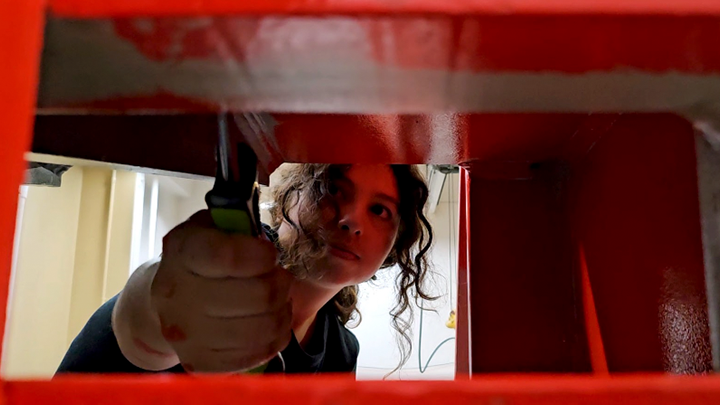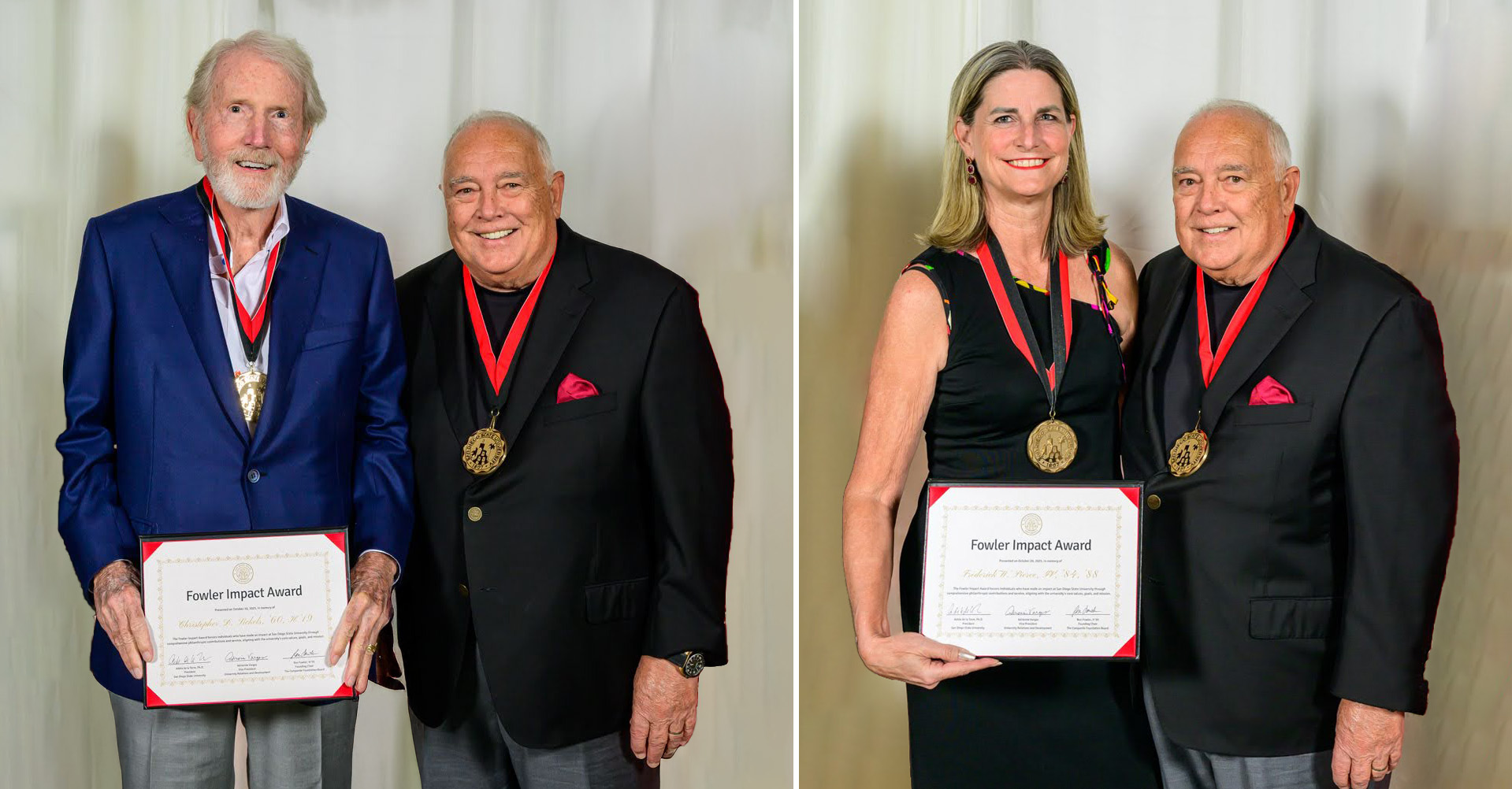‘King Kong’ invades SDSU’s Structural Engineering Laboratory
Undergraduate engineering students build a giant mechanical structure to test the destructive force of earthquakes.

A team of undergraduate engineering students at San Diego State University have built a large mechanized structure dubbed “King Kong” to test the impact of earthquakes on buildings and bridges. The 15-foot-tall machine — resembling a giant red LEGO tower on a black, 240 sq. foot platform — is named for the size and strength of the classic movie monster.
It will simulate the shaking of a major (7.0-7.9 magnitude) earthquake.
“We’ll be able to apply about a half million pounds of force laterally at the top of structures back and forth until the structure actually completely fails — we're talking full-scale building structures or half-scale bridge structures,” said associate professor and director of the Structural Engineering Laboratory, Robert Dowell, who mentors the students working on King Kong. The results of the tests will confirm whether structural calculations incorporated during the design process will actually prevent the collapse of these structures in a future large earthquake.
The machine is officially known as the Thomas F. Dowell Structural Testing Facility, named in honor of Dowell’s father, who was a structural engineer at Rohr Industries — once the largest employer in San Diego.
The project came about after the devastating 7.8 and 7.5 magnitude earthquakes that shook southern Turkey and northern Syria on Feb. 6, 2023. Dowell traveled to Turkey with a structural engineering reconnaissance team to survey bridge damage.
“When I came back, I wrote a report on the extreme and unusual bridge damage that I saw and how it related to California bridges,” said Dowell.
He realized there was an urgent need to test bridge designs back home because California’s future “Big One” is expected to rival the Turkey–Syria quakes in magnitude. The last temblor of this size in California was the devastating 1906 San Francisco earthquake, which at approximately 7.9 magnitude, killed more than 3,000 people and destroyed 80% of the city. More recently, the relatively tame 1994 Northridge earthquake at 6.7 magnitude killed more than 50 people, and caused an estimated $40 billion in damage.
The East Anatolian fault behind the 2023 Turkey-Syria earthquakes and the San Andreas fault are both strike-slip faults. These occur when two tectonic plates slide past each other, like two trains passing each other along parallel tracks. The San Andreas fault occurs where the Pacific and the North American Plates meet, and runs north and south along the California coast.
Dowell’s report on bridge damage in Turkey caught the attention of Caltrans, which oversees the state’s highway system. The agency has now committed more than $1 million for testing the seismic resilience of bridge columns and precast concrete girders at SDSU using King Kong.
Inside the SDSU Structural Engineering Laboratory, researchers will be testing half-scale, reinforced concrete bridge columns under earthquake-like conditions. These tests will help engineers understand how well the columns can withstand extreme forces before breaking.
“Whatever Caltrans does — it spreads across the whole U.S. and beyond, everyone looks to us,” said Dowell. “I think this could put us at the forefront of bridge earthquake research across the United States.”
Assistant professor of structural engineering Gloria Faraone, a co-PI on the Caltrans grants, also has funding from the National Science Foundation to test full-scale timber walls with concrete footings.
“After an earthquake, we may expect a lot of damage in regions where the wall connects with the footing,” said Faraone. “If we're able to modify this connection, then we may get a better performance of the whole wall.”
King Kong works by applying a lateral, or horizontal load. Its vertical tower is attached to a 10-foot long hydraulic actuator weighing more than 10,000 pounds. The structure being tested is bolted to the hydraulic actuator as well as to the bottom platform.
From a computer, researchers control a piston that pushes and pulls horizontally on the structure, simulating intensities measured in previous earthquakes or expected in future earthquakes. The displacements are increased in cycles, causing the structure to move back and forth until it fails.
King Kong applies its load slowly, allowing damage and failure to be observed as if watching a slow-motion car crash. Vertical force is also applied, representing the weight of the bridge or building.
These tests will help ensure that structures are built to withstand more than the maximum displacement of any future earthquake.
According to Dowell, King Kong allows for more control over the intensity of displacement than traditional earthquake shaking tables and is better for testing large structures.
A team effort
King Kong was designed and built entirely at SDSU. Under the mentorship of Dowell, Faraone and lab technician/lab manager Greg Morris, the students retrofitted an existing machine once used to test full-scale ship parts.
“We're rearranging and repurposing all the materials used, all the big steel pieces,” said Carlos Navea, an undergraduate civil engineering major. “We've been drilling into it, grinding it down, trying to make it multifunctional.”
The team worked on King Kong throughout the spring and summer. Once they overcame the challenges of retrofitting the massive structure, they had a painting party, slathering King Kong’s tower in red and its platform in black — SDSU’s colors.
The project has equipped the students with valuable hands-on skills to better understand their use in the professional world, according to Dowell.
“Many of them have never really worked with drills, hand tools or power tools before,” he said. “They're all taught how to use them appropriately and what safety features to wear. Drilling through two-inch thick steel plate into another steel plate, you want to make sure you have the right goggles on.”
The first tests of King Kong’s might are slated for early fall with ¼-scale reinforced concrete bridge columns, followed by tests on full-size walls. And in the future, Dowell and company have plans to build a giant outdoor wave-making tank to test structures under tsunami loading.
The undergraduates who built King Kong include An Khang Diec, Carlos Navea, Diego Osorio, Elisa Correa Gallegos, Isabella Burnette, Jared Maestri, Omar Lizarraga, Peter Husch, Ramin Sarange, Stefan Conlee and Sid Weddington.


